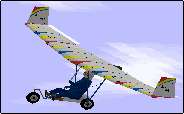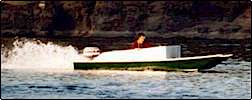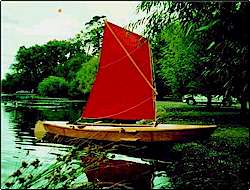My Life in The Boating Business
By Bernie Wolfard
 I had just spent 9 years of my life
running a non-profit health organization. During this time I started building fine
furniture as an excuse to buy power tools so I could ease into what I really wanted to do
without causing too much alarm in those that cared for me. You see, I am in a wheelchair
because of a 3000-foot fall in a hang glider, and my dream was to build a wooden airplane
and start flying again. So, when I started fabricating intricate precision wooden parts in
my shop, no one paid to much attention, at least at until the 36’ wing of my airplane
outgrew my shop. I had just spent 9 years of my life
running a non-profit health organization. During this time I started building fine
furniture as an excuse to buy power tools so I could ease into what I really wanted to do
without causing too much alarm in those that cared for me. You see, I am in a wheelchair
because of a 3000-foot fall in a hang glider, and my dream was to build a wooden airplane
and start flying again. So, when I started fabricating intricate precision wooden parts in
my shop, no one paid to much attention, at least at until the 36’ wing of my airplane
outgrew my shop.
 I only got to fly my creation for one season before I made a mistake and had
to make a decision about whether to hit high power lines or a barbwire fence. I chose the
fence, which destroyed my beautiful flying machine along with my flying dream. I decided
on the spot to start building boats because at I didn’t know how bad drowning would
hurt. Crashing I knew. I only got to fly my creation for one season before I made a mistake and had
to make a decision about whether to hit high power lines or a barbwire fence. I chose the
fence, which destroyed my beautiful flying machine along with my flying dream. I decided
on the spot to start building boats because at I didn’t know how bad drowning would
hurt. Crashing I knew.
 I had put my wife through
medical school with a non-profit management job, and about the time we were ready to move
to Baltimore I received a letter from Elrow Larow, the man I had bought plans from for my
first boat project, a MICRO. Boat building was my winter therapy replacement for airplane
building. I then prototyped two more boats for Elrow, a FISHCAT and PIROGUE. Sadly, Elrow
had a stroke and could no longer manage his little Bolger plans business. The letter
started by saying he wanted to will me the business. On the third paragraph Elrow started
talking about terms. I had put my wife through
medical school with a non-profit management job, and about the time we were ready to move
to Baltimore I received a letter from Elrow Larow, the man I had bought plans from for my
first boat project, a MICRO. Boat building was my winter therapy replacement for airplane
building. I then prototyped two more boats for Elrow, a FISHCAT and PIROGUE. Sadly, Elrow
had a stroke and could no longer manage his little Bolger plans business. The letter
started by saying he wanted to will me the business. On the third paragraph Elrow started
talking about terms.
 This was just what I wanted, my own business.
Actually, this was business number 3 (NEST AIRCRAFT & Wolfard construction are
priors). Non-profit management just didn’t fulfill my lifelong entrepreneurial urges
and the timing of Elrow’s offer couldn’t have been better. I was in the process
of moving to Baltimore for my first wife’s medical school residency. After six years
of supporting a budding Dr. I was ready to do something more in line with my proclivities.
Part of my preparation to take over Elrow’s business was to trade my MICRO for a
state of the art computer (a 286 with 640 K ram & amber monochrome monitor). This was just what I wanted, my own business.
Actually, this was business number 3 (NEST AIRCRAFT & Wolfard construction are
priors). Non-profit management just didn’t fulfill my lifelong entrepreneurial urges
and the timing of Elrow’s offer couldn’t have been better. I was in the process
of moving to Baltimore for my first wife’s medical school residency. After six years
of supporting a budding Dr. I was ready to do something more in line with my proclivities.
Part of my preparation to take over Elrow’s business was to trade my MICRO for a
state of the art computer (a 286 with 640 K ram & amber monochrome monitor).
 Baltimore was very hot and strange
for a west coast boy, so after getting divorced and going to work for another rehab
program, I decided to move back to Portland. I felt that because all of my support systems
were in Portland I would have a better chance of making a go at running the boat plans
business full time. The one legacy Baltimore had on the plans business was the name,
COMMON SENSE DESIGNS. It popped into my head while driving down the beltway after getting
my car air conditioner recharged. In that instant I realized I had the perfect name for a
Bolger boat plans business. Also, for those who know me well, somewhat of an in-joke. Baltimore was very hot and strange
for a west coast boy, so after getting divorced and going to work for another rehab
program, I decided to move back to Portland. I felt that because all of my support systems
were in Portland I would have a better chance of making a go at running the boat plans
business full time. The one legacy Baltimore had on the plans business was the name,
COMMON SENSE DESIGNS. It popped into my head while driving down the beltway after getting
my car air conditioner recharged. In that instant I realized I had the perfect name for a
Bolger boat plans business. Also, for those who know me well, somewhat of an in-joke.
Back in Portland I put my "back"
into CSD, developing a catalog, an advertising and PR strategy and built the first COMMON
SENSE SKIFF, the boat I still own. One day I got the wild idea of asking Bolger if he
would let me market some of the boat plans he had drawn that were gathering dust in his
plans drawer on Resolution. He wrote back that he didn’t see any problems with the
idea but because he had so many plans we would need some sort of criteria to pick plans
that would fit CSD. It was Phil who came up with the criteria, one that fit the man and
his dry sense of humor. The criterion was, any plan that Bolger liked after it was
built, the owner thought was a good boat and the owner still liked Bolger.
CSD went from 12 plans to 56 almost overnight. I developed the
CSD Plans Book, which was much more than a mere catalog. In fact the book has an ISBN
number. Business was doing great until the late and lamented magazine, Small Boat
Journal sold out and became something like Metal-Flake Overpowered Trailerable Bass
Boats. Sales at that point were almost evenly distributed between Wooden Boat
and Small Boat Journal advertising. The demise of SBJ cut sales in half. Things
were no longer going so great.
I started frantically trying to find effective advertising
sources to replace SBJ. The old standby Populars (Scientific and Mechanics) seemed to have
become branches of the military and most boating magazines catered to the wine and cheese
crowd. The reason SBJ went away, in retrospect, was obvious. By catering to
"real" boaters who know that the enjoyment of a boat is inversely proportional
to its size, they were also appealing to a group that knew you didn’t have to be a
corporate raider to afford to go boating. The big dollar advertisers (electronics and
outboard motor manufacturers) also knew this and stayed away. After a couple of years of
hard work I was able to get the business back up to about ¾ of where it was with SBJ.
 About this time I asked Bolger to design a boat
fast enough to cruise the North West rivers. His answer was IDAHO, which I subsequently
built. About this time I asked Bolger to design a boat
fast enough to cruise the North West rivers. His answer was IDAHO, which I subsequently
built.
I also got married again to a wonderful woman and as a result
had more domestic responsibilities. We bought a house and with the increase in monetary
commitment it was becoming clear that CSD just couldn’t be expected to produce enough
income to support a decent life style. Then the other shoe dropped.
Bolger got married. This was wonderful for Phil but dramatically
changed the relationship between Bolger & CSD. Phil’s new wife had other ideas
about how Phil should run his business, and CSD didn’t fit into the plans. Instead of
getting involved in an unseemly court battle, I returned all but the plans CSD paid Bolger
to design and thereby owned. I went from 56 plans to 10.
After this my first reaction was to try to sell CSD. When no
buyers were forthcoming I was stuck with the decision of either closing the doors or
trying to dramatically expand the business. After writing several business plans, it
looked like the best course of action would be to expand. Many plans customers had asked
for kits, so I believed I could leverage my existing customer base of over 10,000 plans
buyers into kit buyers. I built a business plan around my customer base and set out to
fund it.
 It took an agonizing six
months to raise the funds for the new business plan and once funded, I was committed. The
first sign of trouble came when, after the best of my efforts, I didn’t sell any kits
to my existing customer base. In the process of trying to turn plans into kits, developing
new plans and kits and building a business from the ground up, I had a business plan that
called for a six month break even based on my existing market. When the existing CSD
market didn’t respond I had to develop a new market that rule of thumb said was going
to take three years to get to break even and 12 months of capital. Was I busy! It took an agonizing six
months to raise the funds for the new business plan and once funded, I was committed. The
first sign of trouble came when, after the best of my efforts, I didn’t sell any kits
to my existing customer base. In the process of trying to turn plans into kits, developing
new plans and kits and building a business from the ground up, I had a business plan that
called for a six month break even based on my existing market. When the existing CSD
market didn’t respond I had to develop a new market that rule of thumb said was going
to take three years to get to break even and 12 months of capital. Was I busy!
At 18 months things were bleak. Sales where picking up, we had
some great new boats and kits but we were running out of money. Worn out from juggling
inadequate funds, I had a meeting with a CPA and an attorney then decided to close the
doors. The irony is, once I made the decision I received orders for a MICRO TRAWLER kit
and a MICRO kit, roughly $12,000 worth of orders, unfortunately too little too late.
So now I no longer own a boat business.
They always say the way to make a small fortune in the boat business is to start with a
large fortune. But, after 14 years, the business seems to have a life of its own. My
partner in kits business, Jerry Estes, took over the plans business and has added books and Race-Lite rigging parts to CSD’S offerings. The business is now called COMMON SENSE BOATS. I keep my hand in by doing web site development and marketing.
Is there a moral here? Perhaps I could blame plans builders who
I am fond of pointing out "won’t spend 10 cents a minute for a long distance
call to god," but in fact this an admirable trait that defines a wonderful creative
group of people. It also gets close to blaming the victim. The real issue is risk taking
and risk tolerance. To start and run your own business is a risky enterprise with a high
probability of failure. Failure is a right of passage for any entrepreneur. This, of
course, does not make failure easier or more palatable. Loosing CSD was a major blow. But
there is solace in the idea that I introduced many to the wonders of building their own
boat, and in some small way helped many go from dreamer to doer. Does anyone out there
know how to equip a training sailplane with hand controls? |